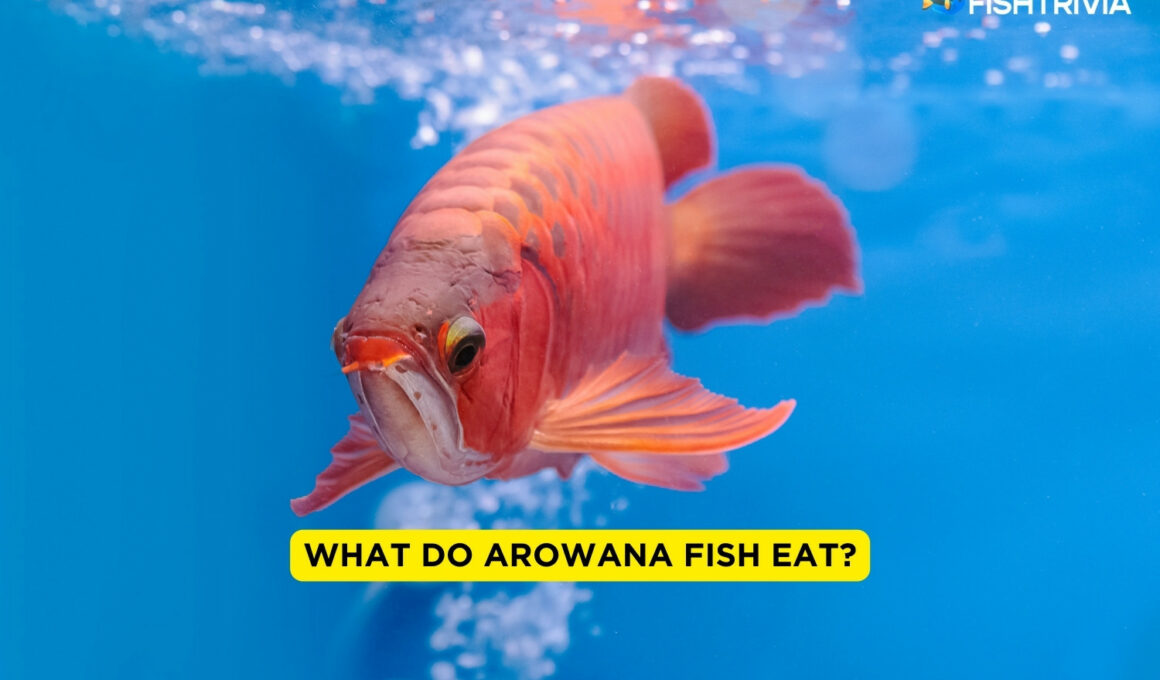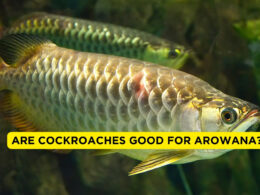In this article Show
An Arowana fish is a monster type of fish known to feed on anything that fits its mouth. It is usually found in Southeast Asian countries and South America. They are usually long and sleek with large scales and pairs of barbells.
The Arowana fish is also known as the dragon fish, and a different type is known as the Chinese dragon since it is similar to the Chinese dragon.
When you choose to keep an Arowana fish as a pet, you need to be very keen on feeding your fish. You should always make sure that your Arowana fish is taking nutritious pellets and also wild foods.
For example, small fish, amphibians, and crustaceans. They also feed on insects and arthropods due to their predatory nature.
Also worth reading;
- Why Are Asian Arowana Illegal? What You Should Know
- Are Arowana Fish Aggressive? All You Need to Know
- Why Are Asian Arowana So Expensive? (Explained)
- 19 Best Arowana Tank Mates
Diet For The Wild Arowana Fish
There is a predatory aspect to Arowanas. In the wilderness, they dwell mostly in floodplains, feeding on insects as well as small livestock. Arowanas also feed amphibians, arthropods, and tiny fish.
Research has also shown that birds and animals occasionally consume fish. However, crustaceans and tiny fish are their preference in the wild. Because of the mouth, Arowanas swims slightly under the water and jumps up to grab its prey.
Interesting footage of them jumping from the water may be seen in tree branches reaching insects. You may capture fish by swimming slightly under them before they scoop.
Best Food In The Aquarium For Arowana Fish
It would be best if you reflected on Arowana’s diet as widely as possible to ensure they prosper and are maximally comfortable in your water. This implies that there should be more living food as possible to be included in the diet.
However, variety is important to keep your fish from developing a nutritional deficit. Crickets, cockroaches, and centipedes may be included as insect foods for the Arowanas.
Crickets are nourishing and have a minimal danger of transferring illness to your fish since most crickets are ill-free and so they rarely get ill.
However, it would help if you mainly chose farm-bred cricket since wild-caught crickets frequently become polluted with pesticides. Note that the wild crickets are not as bad as they could seem, only that they have come across many pesticides, making them a little bit contaminated.
Crickets are excellent vitamin A sources. Set yourself on live farms to reduce the probability of inserting chemicals into your aquarium. Frozen centipedes are also highly recommendable as they will improve your Arowana fish’s color and act as food for the fish at the same time.
In the diet of Arowana fish, there are also important amphibians such as geckos, lizards, frogs, crustacean-like shrimps, crustaceans, and worms are a favorite meal for the Arowana, for example, earthworms, mealworms, and other worms. Fish flesh may also be included in your pet’s diet.
Always ensure that before cutting the small fish or amphibians to bite sizes and washing, the fat is completely cut, and no traces of fat can be traced. An aquarium diet of Arowana fish is inadequate without pellet food.
Pellet foods should not be considered as the day-to-day meal of the Arowana. This may lead to starving the Arowana, and it can get stressed up and start jumping out of the tank.
There are numerous commercially available pellet meals with different nutritional contents for your fish. Nevertheless, pellet meal should be utilized as additional feed since it has been linked with a bulging anus in Arowanas.
Estimated Time To Feed The Arowana Fish
The Arowana fish should frequently be fed to maintain their growth rates up twice a day maximally. However, as they increase, the rates of growth of the Arowanas and their metabolism will slow down.
Naturally, their hunger will also slow down. As such, you may feed your Arowana fish once daily for adults and sub-adults.
Fortunately, Arowana fish will lose food once they are full, so you won’t have to worry about overfeeding. To this purpose, if they take food, you may continue to feed them as this shows they are not yet full.
Just ensure that all the remaining food is removed soon after your meal such that the levels of ammonia are not increased, or any other toxic substance will not build up in the Arowana’s tank.
How Long Is Arowanas Able To Go Without Food?
Many factors may prevent your fish from eating. Common ones include limited tank space, incompatible tank cockroaches, illness, poor water parameters, disease, and a continual supply of the same food.
Arowana fish may also lead to a lack of appetite, a breeding effect, and a shorter lifespan.
Arowanas can generally be without food for around three weeks without problems. If the fish does not eat beyond this period, contact a professional to study and fix the reason. In other terms, this prevents nutritional shortcomings that may have long-term effects.
Can Arowanas Eat Little Fish?
As stated above, in nature, tiny fish make up a large part of the diet of Arowana fish. Fish should thus similarly be included in your pet’s food in an aquarium.
Live fish, such as catfish, goldfish feeder, and meadow fish, may perfectly replace Arowana fish’s wild diet.
You may feed these tiny fish with medicine and nutrition before being fed into the Arowanas and transferred to them. This prevents the small fish from transferring illnesses or diseases to the Arowana fish.
Goldfish may also be used sparingly in the diet of your Arowana fish. This is high in fat, important to prevent eye problems in the Arowana fish. However, too much of it may induce Arowana’s nutritional deficits. Isolate the Arowana fish for at least five days before feeding tiny fish to a fish in Arowana to prevent illness transmission.
Caring for such a large fish as an Arowana will be both overwhelming and tough at the same time. Regardless of how experienced one could be, Arowanas tend to be very demanding.
However, once you understand its feeding, it will be a breeze to maintain an Arowana fish, and your animals will prosper. Thankfully, the preceding information will make feeding the fish and its general care easier.
Still, you should invest in healthy Arowana fish initially. Choose one who is constantly swimming, responsive and attentive when you purchase your fish.
The healthy Arowana fish is also one of the radiant and complete dimensions, with completely straightened fins, protruded veins, and fresh red and brilliant gills.
Conclusion
Arowana fish are carnivorous, and a broad range of meals should be given. Live and frozen meals are included.
Fish food from Arowana comprises (but is not limited to) surface pellets feeding predators, worms, grasshoppers, crickets, caterpillars, tiny frogs, feeder fish, Mysis, and salami with shrimps eaten by men. Arowana may also be given little beef and poultry heart and liver.
Things to remember for your Arowana feeding: The Arowana fish are surface feeders that frequently glide just under the surface of the water. Feed young fishes 2-3 times per day, mature once per day; feed in only one to two minutes what they can consume.
Before feeding the Arowana fish, thaw the frozen food. If you have many Arowana fish in one tank, it is always advisable to divide their feeding portions to avoid fights. You can divide the portions by use of nets.










